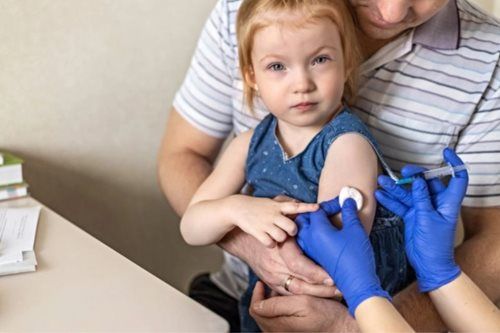What Is The DTaP Vaccine
Pediatricians advocate a thoughtful vaccination schedule for your child that is recommended by the American Academy of Pediatrics and the Centers for Disease Control. It includes mandatory vaccinations for daycare and school.
The DTaP vaccine is an immunization that is generally administered to infants and to children six years of age or younger. This is a multiple component vaccine that helps to protect children against serious illnesses caused by the diphtheria, tetanus, and pertussis organisms. Adults and children over the age of six don’t typically receive DTaP vaccines. Instead, they receive a slightly different vaccine known as Tdap. Since immunity to diphtheria, tetanus and pertussis wanes over time, teens and adults should receive booster doses of Tdap vaccine every ten years.

The DTaP vaccine was carefully developed to be safe for young children. It exposes the child to an antigen (a small particle) from the target bacteria. This promotes the child’s immune system to develop antibodies that will protect them against future infections from the bacteria. It takes time to develop immunity to the bacteria, generally two to four weeks following vaccination. The vaccine, therefore, is not effective at treating current infections.
Without this common, effective, and important vaccine we would see a steep rise in the occurrence of potentially deadly diphtheria, tetanus, and pertussis infections in both children and adults.
The Dangers Of Diphtheria
Diphtheria is a bacterial infection that ravaged small children a century ago. It can easily be spread from person to person. Infected individuals experience an excessively thick coating in the nasal passages, throat, and airways. The inflammation and severe buildup in the breathing passages can lead to severe breathing issues, heart problems, and paralysis. In the past, diphtheria had a fatality rate as high as 20% in children under 5 years old. Even today, unvaccinated children under 2 years of age die from diphtheria around the world.
The Dangers Of Tetanus
Tetanus is a bacterial infection that isn’t directly passed from one human being to another. Instead, tetanus bacteria enter the bloodstream via a cut or puncture wound in the skin. The tetanus organism, formally known as Clostridium tetani, lives as normal flora in the guts of many animals, such as horses, and contaminates the outdoor soil. A bad scrape, a deep wound, or a puncture are ways the organism can infect a human host. Thorough cleaning can help prevent infection with tetanus, but the vaccine is essential for protection.
As tetanus bacteria starts to invade the body, it causes a severe tightening of many key muscles. It is often most prominent in the muscles surrounding the jaw causing “lockjaw” which can be life-threatening in around 20% of cases.
The Dangers Of Pertussis
Also known as “whooping cough”, pertussis does far more than just give adults and children a severe cough. The coughing fits it produces can make it hard to breathe, eat, and sleep. Patients can cough so hard that they become breathless, leading to a loud inspiration or “whooping” sound after a fit. The fact that it lasts for several weeks before the body’s immune system can adapt to defeat it also leaves some people at risk of suffering lung damage. In children and adults, pertussis can be complicated by pneumonia, seizures, brain damage, and in some severe cases, even death. A baby who is infected with pertussis might need to be put on a ventilator for days or weeks to help them breathe.
Is DTaP Included In A Typical Immunization Schedule
Pediatricians recommend including the DTaP vaccine as part of a child’s regular immunization schedule. Dtap is given five times between the ages of 2 months through 4 to 6 years. The first three doses at two to six months establish primary immunity, with boosters at 18 months and four to six years to continue protection. DTaP may be safely administered in conjunction with other vaccinations.
It is always best to try to adhere closely to the recommended schedule of vaccines. The most information is available about the safety and efficacy of vaccines when given this way. Deviating from the schedule could lessen the child’s protection, and leave the child subject to the same pitfalls of “catch-up” immunizations: missed doses, excessive doses, more doctor visits for the child. Also, there is no data that alternative schedules are safer than those recommended.
Tdap is a modified version of Dtap appropriate for older children and adults. Because of waning immunity and rising cases of pertussis in recent years, boosters of Tdap are recommended every ten years beginning at age eleven.
Boosters For Pregnant Women
Obstetricians recommend that pregnant women receive a Tdap booster in the early portion of the third trimester. This helps to protect their newborns from pertussis after birth when pertussis and diphtheria have the highest fatality rate. All family members and regular caretakers should also receive Tdap whenever a new baby is born into the family.
Do Adults Need Boosters
As mentioned above, the CDC recommends that adults receive a Tdap booster every ten years. This helps to maintain a strong immune response should they be exposed to Diphtheria, Tetanus, or Pertussis.
Does the DTaP Vaccine Have Side Effects?
Side effects are a common concern amongst many parents who are getting their children vaccinated. It’s important to understand that the currently recommended vaccines like DTaP have been vigorously tested for decades. Most children do not experience any side effects. The few that do, often experience very mild symptoms. These might include:
- Minor swelling at the vaccination site
- Soreness of discomfort at the vaccination site
- A low-grade fever
- Allergic reactions
These side effects tend to be mild compared to the illness and potentially life-threatening symptoms of catching diseases like diphtheria, tetanus, or pertussis.
What Are The Chances Of My Child Experiencing Side Effects From The DTaP Vaccine?
Statistically, roughly 25% of children will experience redness or soreness at the vaccination site. This typically lasts a day and tends to be more common after the fourth or fifth dose of DTaP.
Roughly a third of children will also be fussy or cranky for a day or two after the injection. Approximately 10% of children will demonstrate fatigue and have a poor appetite. An estimated one out of every 50 children will experience vomiting.
What Should I Do If My Child Develops Side Effects After The DTaP Vaccine?
Your pediatrician might recommend administering appropriate pain medication for mild symptoms such as a low-grade fever or soreness at the vaccine site. A cold pack or a lukewarm bath might also help reduce pain and swelling.
More significant side effects such as very high fever, hives, facial swelling, swelling of the throat, or breathing issues warrant a call to your pediatrician or to emergency assistance, who can advise you of the best course of action.
Should My Child Get The DTaP Vaccine If They Are Sick?
If your child is currently sick with a cold, the flu, or another illness and they have a vaccination scheduled for their next well-child appointment, notify your pediatrician as soon as possible. They can help you assess the situation, and may advise rescheduling the vaccination, though in most cases, the vaccine can be safely and effectively administered as long as the child does not have a fever.

